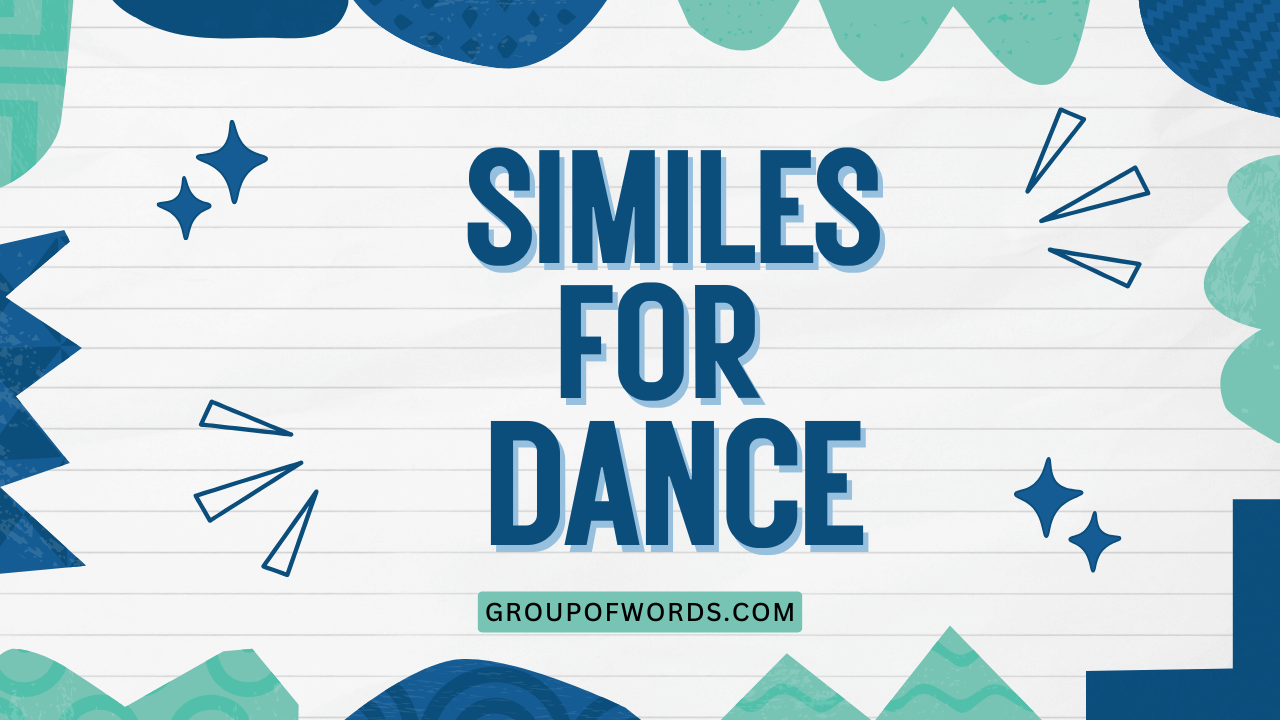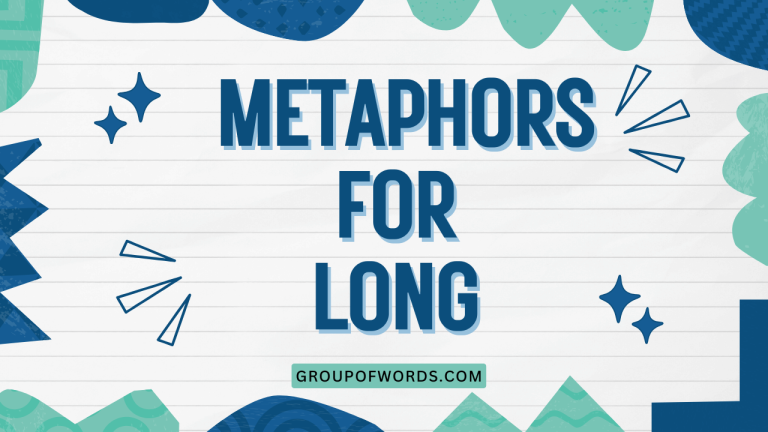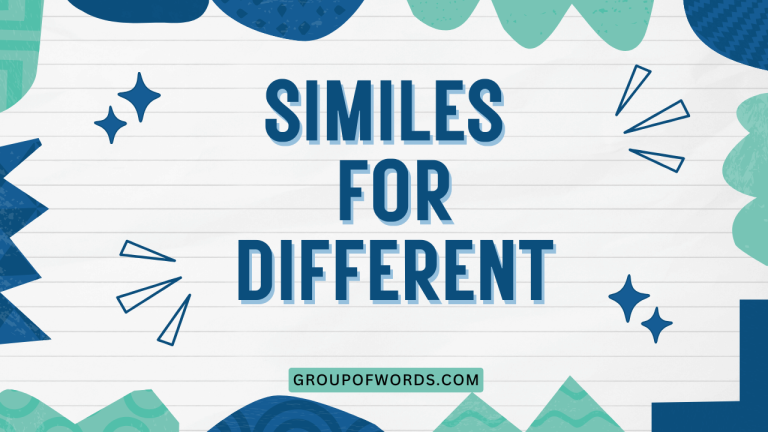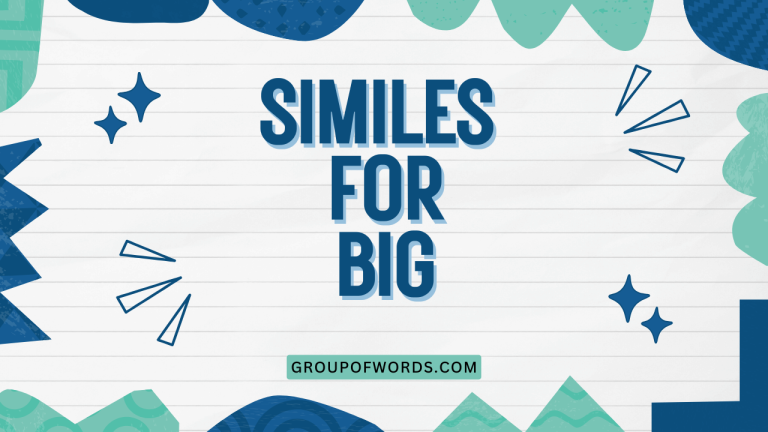Dancing with Words: Mastering Similes for Dance Descriptions
Similes are powerful tools in the English language, allowing us to draw vivid comparisons that enhance our understanding and appreciation of various subjects. When it comes to dance, similes can transform a simple description into a captivating narrative, bringing the movements, emotions, and artistry to life.
This article delves into the art of using similes to describe dance, exploring their structure, function, and application. Whether you’re a dance student, a writer, or simply an admirer of the art form, understanding how to use similes effectively will enrich your ability to communicate about dance with precision and flair.
This comprehensive guide is designed for anyone looking to improve their descriptive writing skills, particularly in the context of dance. It is equally beneficial for English language learners aiming to expand their vocabulary and grammatical knowledge.
By the end of this article, you’ll be equipped with the knowledge and tools to craft compelling descriptions of dance using similes, making your writing more engaging and evocative.
Table of Contents
- Definition of Similes for Dance
- Structural Breakdown of Dance Similes
- Types of Similes Used in Dance Descriptions
- Examples of Similes for Dance
- Usage Rules for Similes in Dance Writing
- Common Mistakes When Using Similes for Dance
- Practice Exercises
- Advanced Topics in Dance Similes
- Frequently Asked Questions
- Conclusion
Definition of Similes for Dance
A simile is a figure of speech that directly compares two different things, typically using the words “like” or “as.” In the context of dance, similes are used to create a more vivid and relatable image of the movements, emotions, or overall aesthetic of a performance. They help bridge the gap between the abstract nature of dance and the concrete understanding of the audience or reader.
Similes function as descriptive tools, adding depth and nuance to dance criticism, reviews, and general conversations about dance. They allow writers and speakers to evoke specific feelings and images, making the dance experience more accessible and engaging.
By drawing parallels between dance and familiar concepts, similes enhance the audience’s appreciation and comprehension of the art form.
Consider the difference between saying “The dancer moved gracefully” and “The dancer moved as gracefully as a swan gliding across a lake.” The latter simile provides a much richer and more evocative image, painting a clear picture of the dancer’s fluidity and elegance.
Structural Breakdown of Dance Similes
The basic structure of a simile involves three key elements: the subject (the dance or dancer being described), the linking word (“like” or “as”), and the object of comparison (something familiar that shares a quality with the subject). Understanding this structure is crucial for constructing effective and meaningful similes.
The formula can be represented as: Subject + Linking Word + Object of Comparison. Let’s break this down further:
- Subject: This is the dance movement, the dancer’s expression, or any aspect of the performance you wish to describe.
- Linking Word: The words “like” or “as” are used to explicitly make the comparison. “Like” suggests similarity, while “as” often implies an equal degree of the shared quality.
- Object of Comparison: This is something tangible or easily imaginable that possesses the quality you want to highlight in the dance. It should be something that the audience can readily relate to.
For example, in the simile “Her leaps were like soaring birds,” “Her leaps” is the subject, “like” is the linking word, and “soaring birds” is the object of comparison. This structure provides a clear and concise way to convey the quality of lightness and freedom associated with the dancer’s leaps.
Types of Similes Used in Dance Descriptions
Similes in dance descriptions can be categorized based on the aspect of dance they emphasize. Here are a few common types:
Similes Describing Movement
These similes focus on the physical actions of the dancers, highlighting their speed, fluidity, and precision. They often use verbs as a basis for comparison.
Similes Describing Emotion
These similes aim to convey the emotional impact of the dance, drawing parallels between the dancers’ expressions or the overall mood of the piece and recognizable feelings or experiences.
Similes Describing Appearance
These similes focus on the visual elements of the dance, such as the costumes, lighting, or the dancers’ physical appearance. They help to create a vivid and memorable image in the reader’s mind.
Similes Describing Sound
While less common, similes can also be used to describe the sounds associated with dance, such as the music, the tapping of shoes, or the rustling of costumes. These similes add another layer of sensory detail to the description.
Examples of Similes for Dance
To illustrate the effective use of similes in dance descriptions, let’s explore several examples categorized by the aspects of dance they describe.
Movement-Focused Similes
The following table provides examples of similes that describe the movement of dancers, highlighting various qualities such as speed, fluidity, and power. Each example aims to create a vivid image of the dancer’s actions.
| Simile | Explanation |
|---|---|
| Her spins were like a whirlwind, captivating and unstoppable. | This simile emphasizes the speed and intensity of the dancer’s spins. |
| His jumps were as weightless as dandelion seeds in the wind. | This simile highlights the lightness and ease of the dancer’s jumps. |
| The dancers moved together like a school of fish, synchronized and fluid. | This simile emphasizes the unity and smoothness of the dancers’ movements. |
| Her arms flowed like water, graceful and continuous. | This simile conveys the fluidity and elegance of the dancer’s arm movements. |
| His footwork was as intricate as a spider’s web, delicate and precise. | This simile highlights the complexity and precision of the dancer’s footwork. |
| Their bodies swayed like reeds in the breeze, gentle and responsive. | This simile emphasizes the flexibility and responsiveness of the dancers’ bodies. |
| The ballerina’s extensions were like arrows, sharp and direct. | This simile conveys the precision and power of the ballerina’s extensions. |
| His leaps soared as high as a kite dancing in the sky. | This simile emphasizes the height and freedom of the dancer’s leaps. |
| She floated across the stage like a whisper. | This simile conveys how silent and graceful the dancer was. |
| The dancers’ steps were as synchronized as the ticking of a clock. | This simile highlights the precision and timing of the dancers. |
| The dancer landed as softly as a feather falling to the ground. | This simile emphasizes the gentleness and control of the dancer’s landing. |
| The choreography was as complex as a Rubik’s Cube. | This simile emphasizes the complexity of the choreography. |
| The dancer’s movements were as smooth as silk. | This simile emphasizes the fluidity of the dancer’s movements. |
| The dancers moved as one as if they were connected by invisible strings. | This simile emphasizes the unity and harmony of the dancers. |
| His leaps were like a powerful spring uncoiling. | This simile emphasizes the energy and force of the dancer’s leaps. |
| Her turns were as quick as a hummingbird’s wings. | This simile emphasizes the speed of the dancer’s turns. |
| They danced like shadows, elusive and mysterious. | This simile emphasizes the enigmatic quality of the dancers. |
| The dancer’s flexibility was like that of a rubber band. | This simile emphasizes the dancer’s flexibility. |
| His balance was as steady as a rock. | This simile emphasizes the dancer’s balance. |
| The dancer’s movements were as rhythmic as a heartbeat. | This simile emphasizes the rhythm of the dancer’s movements. |
Emotion-Focused Similes
The following table provides examples of similes that describe the emotions conveyed by the dancers, highlighting various feelings such as joy, sorrow, and anger. Each example aims to create a connection between the dance and the audience’s emotional understanding.
| Simile | Explanation |
|---|---|
| Her smile was like sunshine, radiating warmth and happiness. | This simile emphasizes the joy and positivity conveyed by the dancer’s smile. |
| His eyes were as dark as a stormy night, filled with sorrow and despair. | This simile highlights the sadness and hopelessness expressed in the dancer’s eyes. |
| The dance felt like a passionate argument, full of tension and conflict. | This simile emphasizes the intensity and conflict conveyed by the dance. |
| Her movements were as fragile as a butterfly’s wings, expressing vulnerability. | This simile conveys the dancer’s delicate and vulnerable emotions. |
| His anger surged like a volcano, powerful and destructive. | This simile highlights the intensity and destructiveness of the dancer’s anger. |
| Their love story unfolded like a tender poem, soft and beautiful. | This simile emphasizes the tenderness and beauty of the love story portrayed in the dance. |
| The longing in her dance was like a siren’s call, drawing you in. | This simile conveys the captivating and alluring nature of the dancer’s longing. |
| The dancers’ joy was as contagious as laughter. | This simile highlights the infectious quality of the dancers’ happiness. |
| Her sadness was like a heavy cloak, weighing her down. | This simile conveys the burden and weight of the dancer’s sadness. |
| His fear was as palpable as a cold sweat. | This simile emphasizes the tangible and intense nature of the dancer’s fear. |
| The dancers’ passion burned like a wildfire. | This simile emphasizes the intensity and passion of the dancers. |
| Her hope shone like a beacon in the darkness. | This simile emphasizes the hope the dancer is feeling. |
| Their despair hung in the air like a thick fog. | This simile emphasizes despair. |
| The dancers’ energy was like an electric current, surging through the room. | This simile emphasizes the dancers’ energy. |
| Her determination was as strong as steel. | This simile emphasizes the dancer’s determination. |
| Their resilience was like a tree bending in the wind, never breaking. | This simile emphasizes the dancers’ resilience. |
| The dancer’s solitude was as vast as a desert. | This simile emphasizes the dancer’s solitude. |
| Her grief was like a deep wound, slow to heal. | This simile emphasizes the dancer’s grief. |
| Their forgiveness was as gentle as a spring rain. | This simile emphasizes the dancers’ forgiveness. |
| The dancer’s vulnerability was like a newborn’s innocence. | This simile emphasizes the dancer’s vulnerability. |
Appearance-Focused Similes
The following table provides examples of similes that describe the visual aspects of the dance, such as costumes, lighting, and the dancers’ physical appearance. Each example aims to create a vivid and memorable image in the reader’s mind.
| Simile | Explanation |
|---|---|
| Her dress shimmered like moonlight on water, ethereal and captivating. | This simile emphasizes the beauty and elegance of the dancer’s dress. |
| The stage lighting was as warm as a summer sunset, creating a cozy atmosphere. | This simile highlights the warmth and comfort created by the stage lighting. |
| His costume was like a knight’s armor, strong and imposing. | This simile conveys the strength and power associated with the dancer’s costume. |
| The dancers’ makeup was as flawless as porcelain, enhancing their features. | This simile emphasizes the perfection and beauty of the dancers’ makeup. |
| The set design was like a surreal painting, dreamlike and imaginative. | This simile highlights the creativity and imagination of the set design. |
| Her hair flowed like a golden waterfall, cascading down her back. | This simile emphasizes the beauty and abundance of the dancer’s hair. |
| The stage was as bare as a blank canvas, ready to be filled with movement. | This simile conveys the simplicity and potential of the stage setting. |
| The costumes were as vibrant as a rainbow after a storm. | This simile emphasizes the vibrancy and beauty of the costumes. |
| The dancers’ silhouettes were like shadows dancing in the night. | This simile conveys the mysterious and ethereal quality of the dancers’ silhouettes. |
| The stage shimmered like a mirage in the desert. | This simile emphasizes the dreamlike and illusory quality of the stage. |
| Her eyes sparkled like diamonds. | This simile emphasizes the beauty of the dancer’s eyes. |
| The stage was set like a scene from a fairy tale. | This simile emphasizes the magical setting. |
| His presence was as commanding as a king’s. | This simile emphasizes the dancer’s commanding presence. |
| Her elegance was like that of a swan. | This simile emphasizes the dancer’s elegance. |
| The lighting shifted like the colors of a chameleon. | This simile emphasizes the changing nature of the lights. |
| The dancers’ movements were as synchronized as the changing of the tides. | This simile emphasizes the dancers’ movements. |
| The set was as intricate as a clockwork mechanism. | This simile emphasizes the detail of the set. |
| Her voice was like a melody. | This simile emphasizes the beauty of the dancer’s voice. |
| His face was as expressive as a mime’s. | This simile emphasizes the expressiveness of the dancer’s face. |
| The dancer’s smile was like a spring day. | This simile emphasizes the joy of the dancer’s smile. |
Usage Rules for Similes in Dance Writing
While similes are a great way to enhance your writing, it’s important to use them correctly. Here are some rules to keep in mind:
- Ensure Relevance: The object of comparison should have a clear and logical connection to the subject. Avoid making comparisons that are too abstract or far-fetched.
- Maintain Clarity: The simile should enhance understanding, not confuse the reader. Choose objects of comparison that are widely known and easily understood.
- Avoid Clichés: Steer clear of overused similes that have lost their impact. Instead, strive to create fresh and original comparisons.
- Consider Tone: The simile should match the tone and style of your writing. A formal piece might require more sophisticated comparisons, while a casual review might allow for more playful similes.
- Use Sparingly: Overusing similes can make your writing feel cluttered and artificial. Use them strategically to highlight key moments or qualities of the dance.
- Be Specific: Instead of saying “The dance was like something beautiful,” be specific: “The dance was like a blossoming flower, unfolding its petals with grace.”
Common Mistakes When Using Similes for Dance
Even experienced writers can make mistakes when using similes. Here are some common pitfalls to avoid:
| Incorrect | Correct | Explanation |
|---|---|---|
| The dance was like good. | The dance was like a dream, ethereal and captivating. | The object of comparison should be a noun or noun phrase, not an adjective. |
| Her jumps were like air. | Her jumps were like soaring through the air, effortless and free. | The simile should provide a clear and meaningful comparison. |
| His movements were as fast as light. | His movements were as fast as a lightning strike, sudden and powerful. | While “light” is fast, “lightning strike” is more descriptive and impactful. |
| The dance was like everything. | The dance was like a symphony, a harmonious blend of movement and emotion. | The object of comparison should be specific and relevant. |
| Her sadness was like sad. | Her sadness was like a silent tear, conveying deep sorrow. | Avoid using the same word in both parts of the comparison. |
Practice Exercises
Test your understanding of similes by completing the following exercises. Fill in the blanks to create effective similes for dance descriptions.
Exercise 1: Movement
Complete the following similes to describe movement:
- Her turns were as fast as ____________.
- His leaps were like ____________.
- The dancers moved together like ____________.
- Her arms flowed like ____________.
- His footwork was as intricate as ____________.
- Their bodies swayed like ____________.
- The ballerina’s extensions were like ____________.
- His jumps soared as high as ____________.
- She floated across the stage like ____________.
- The dancers’ steps were as synchronized as ____________.
Answer Key:
- Her turns were as fast as a spinning top.
- His leaps were like a soaring eagle.
- The dancers moved together like a flock of birds.
- Her arms flowed like a gentle river.
- His footwork was as intricate as a finely woven tapestry.
- Their bodies swayed like trees in the wind.
- The ballerina’s extensions were like arrows shot from a bow.
- His jumps soared as high as a kite in the sky.
- She floated across the stage like a whisper on the wind.
- The dancers’ steps were as synchronized as the ticking of a clock.
Exercise 2: Emotion
Complete the following similes to describe emotions:
- Her smile was like ____________.
- His eyes were as dark as ____________.
- The dance felt like ____________.
- Her movements were as fragile as ____________.
- His anger surged like ____________.
- Their love story unfolded like ____________.
- The longing in her dance was like ____________.
- The dancers’ joy was as contagious as ____________.
- Her sadness was like ____________.
- His fear was as palpable as ____________.
Answer Key:
- Her smile was like sunshine on a spring morning.
- His eyes were as dark as a moonless night.
- The dance felt like a passionate argument.
- Her movements were as fragile as a butterfly’s wing.
- His anger surged like a raging fire.
- Their love story unfolded like a beautiful poem.
- The longing in her dance was like a siren’s call.
- The dancers’ joy was as contagious as laughter.
- Her sadness was like a heavy cloak.
- His fear was as palpable as a cold sweat.
Exercise 3: Appearance
Complete the following similes to describe appearance:
- Her dress shimmered like ____________.
- The stage lighting was as warm as ____________.
- His costume was like ____________.
- The dancers’ makeup was as flawless as ____________.
- The set design was like ____________.
- Her hair flowed like ____________.
- The stage was as bare as ____________.
- The costumes were as vibrant as ____________.
- The dancers’ silhouettes were like ____________.
- The stage shimmered like ____________.
Answer Key:
- Her dress shimmered like moonlight on water.
- The stage lighting was as warm as a summer sunset.
- His costume was like a knight’s armor.
- The dancers’ makeup was as flawless as porcelain.
- The set design was like a surreal painting.
- Her hair flowed like a golden waterfall.
- The stage was as bare as a blank canvas.
- The costumes were as vibrant as a rainbow.
- The dancers’ silhouettes were like shadows dancing in the night.
- The stage shimmered like a mirage in the desert.
Advanced Topics in Dance Similes
For advanced learners, consider exploring more nuanced aspects of similes in dance writing:
- Extended Similes: Develop a single simile over multiple sentences or paragraphs to create a more elaborate and detailed comparison.
- Metaphorical Similes: Combine elements of simile and metaphor to create richer, more symbolic comparisons.
- Cultural Context: Be mindful of cultural differences in understanding and interpreting similes. Use comparisons that resonate with your target audience.
- Subverting Expectations: Intentionally use unexpected or unconventional similes to create a unique and memorable effect.
Frequently Asked Questions
- What is the difference between a simile and a metaphor?
A simile explicitly compares two things using “like” or “as,” while a metaphor implies a comparison by stating that one thing *is* another. For example, “Her dance was like a flowing river” (simile) versus “Her dance was a flowing river” (metaphor).
- How can I avoid using clichés in my similes?
Brainstorm unique and less common comparisons. Think about specific qualities of the dance you want to highlight and find objects or concepts that share those qualities in an unexpected way. Use a thesaurus to find alternative words for common comparisons.
- Can I use similes to describe abstract concepts in dance?
Yes, but it’s important to choose objects of comparison that are easily relatable and understandable. For example, to describe the feeling of freedom in a dance, you could say, “The feeling of freedom in the dance was like the weightlessness of floating in space.”
- How many similes should I use in a dance review?
There’s no fixed number, but use them judiciously. Too many similes can make your writing feel forced and unnatural. Focus on using them strategically to enhance key moments or qualities of the dance.
- What should I do if I can’t think of a good simile?
Don’t force it. Sometimes, a straightforward description is more effective than a weak or contrived simile. You can also try brainstorming with others or looking for inspiration in other art forms, such as poetry or visual art.
- How can I make my similes more vivid?
Use sensory details. Instead of saying “The music was like a sound,” try “The music was like the rustling of leaves in an autumn forest.” Engage the reader’s senses of sight, sound, smell, taste, and touch to create a more immersive experience.
- Is it okay to use similes in academic writing about dance?
Yes, but use them sparingly and with purpose. In academic writing, clarity and precision are paramount. Use similes to illustrate complex ideas or to make your writing more engaging, but avoid using them in place of solid analysis and evidence.
- How can I improve my ability to come up with creative similes?
Practice regularly. Pay attention to the world around you and notice similarities between different things. Read widely and observe how other writers use similes effectively. Keep a notebook of interesting comparisons that you come across.
Conclusion
Mastering the art of using similes can significantly enhance your ability to describe dance in a vivid and engaging way. By understanding the structure, types, and usage rules of similes, you can craft compelling descriptions that bring the movements, emotions, and artistry of dance to life.
Remember to choose relevant and clear comparisons, avoid clichés, and use similes strategically to create the greatest impact.
As you continue to explore the world of dance writing, experiment with different types of similes and find your own unique voice. The more you practice, the more confident and skilled you will become in using similes to capture the beauty and power of dance.
Embrace the challenge, and let your words dance across the page!






